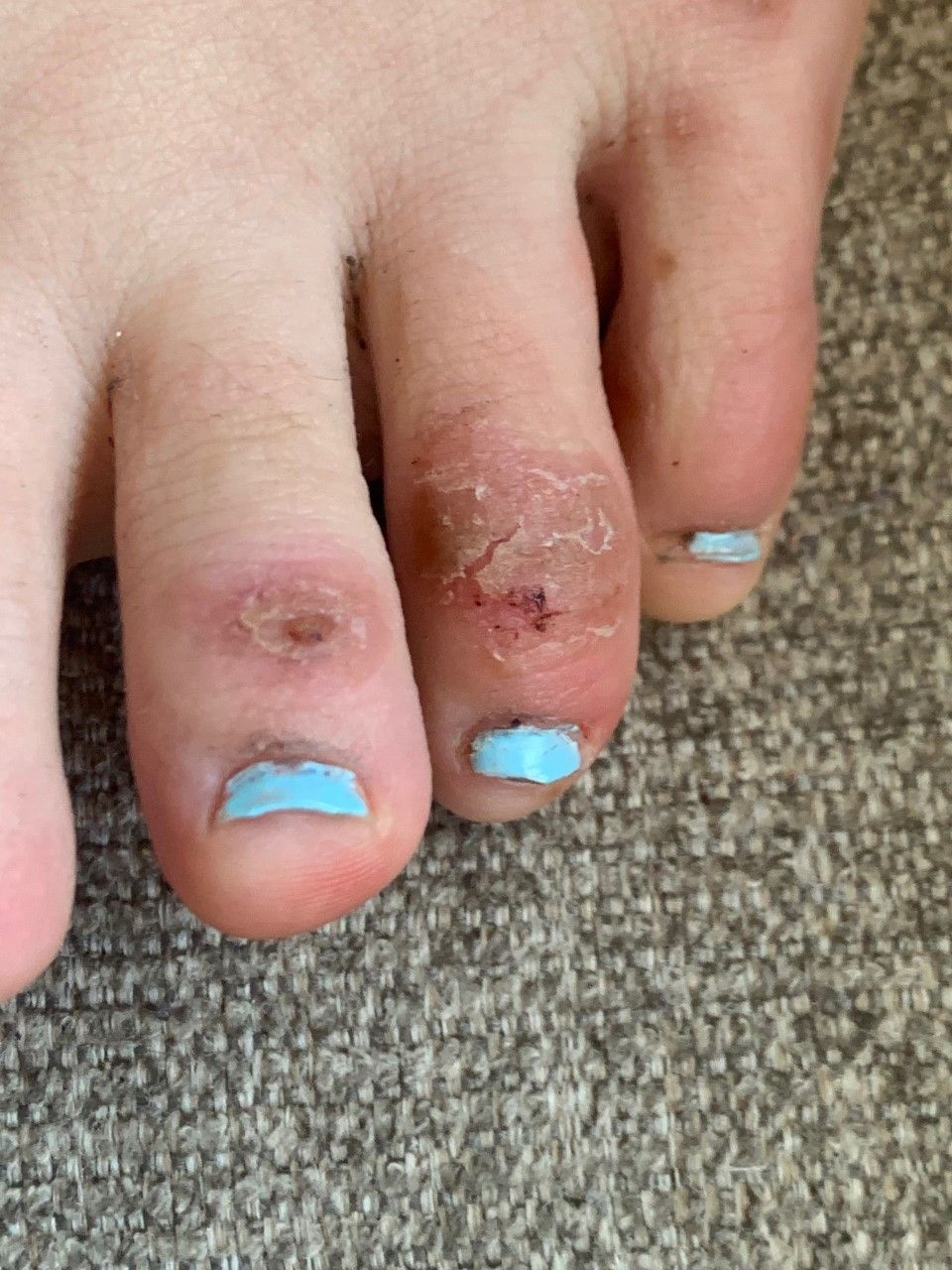- Another unusual symptom of the novel coronavirus has surfaced: discolored toes that look swollen and feel painful to the touch.
- Dubbed “COVID toes,” the rare symptom presents mostly in younger patients.
- Doctors explain what COVID toes look like, plus when to seek treatment.
Doctors have identified another unusual symptom of the novel coronavirus: purple or blue toes that look swollen and feel painful to the touch. Dubbed “COVID toes” by dermatologists, experts say the lesions have been popping up in younger people—sometimes as their first or only sign of COVID-19, the respiratory illness caused by the coronavirus.
“It’s not uncommon, when there’s a viral process, to have skin manifestations,” explains Amy Paller, M.D., department chair of dermatology at Northwestern University and one of the first dermatologists to link the symptom to COVID-19. “This is not just in older children, although I’m seeing it particularly between age 11 and college age.”
Dr. Paller emphasizes that this is an “early observation,” meaning there’s no conclusive research on the symptom and that evidence is purely anecdotal at this point. And not everyone with the symptom has tested positive for the virus, so it’s not totally clear how or whether these lesions are directly related to COVID-19. “Are we just catching it too late, and maybe in the first few days, in some individuals, there is active virus?” Dr. Paller says. “Or is it really a sign of [gradual recovery]? We really don’t know that yet.”
This isn’t the first skin issue linked to COVID-19. One small report from March, compiled by dermatologists who worked with 88 coronavirus patients in Italy, found that 20% of those people had skin-related symptoms. The most common skin condition among these patients was a red, patchy rash.
“We know that there’s more of this, and we suspect it may be related to COVID-19,” Dr. Paller says, but more testing is necessary before any definitive link can be established. Here’s everything doctors know about COVID toes so far—and what to do if this symptom arises.
What do COVID toes look like?

COVID toes look a lot like frostbite or pernio, an inflammatory skin condition that causes sores. This leaves the area looking puffy and discolored, often red or purple, says Dr. Paller. Toes may also feel sensitive, itchy, or painful, and perhaps even like they’re burning. As the symptom runs its course, the affected skin may start to crack and peel as it heals.
Lesions appear on the bottoms or tops of toes, and can also manifest on the fingers, although this is less common, explains Ebbing Lautenbach, M.D., chief of infectious diseases at the University of Pennsylvania’s Perelman School of Medicine.
What’s more, patients often experience COVID toes without other telltale signs of the novel coronavirus, like a fever, dry cough, or shortness of breath. “Almost all of the individuals who are reporting [COVID toes] have no symptoms that we would relate to COVID-19, or very mild ones,” Dr. Paller explains.
Why might the novel coronavirus cause COVID toes?
It’s a bit of a question mark right now, Dr. Lautenbach explains. But experts suspect the skin issue could be a result of both the body’s natural inflammatory response to the virus or “blood clotting issues in people with COVID-19 infections,” he says.
Because COVID toes is more common in young people, that may serve as clue. “We know that the immune response, in general, gets less robust as we get older,” Dr. Lautenbach explains. In turn, COVID toes might be a sign of a “brisk immune response” to the virus, but more research is needed to know for sure.
Dermatologists suspect a similar link in COVID-19 patients who are developing skin rashes, though. “We don’t understand exactly why, but many viruses that cause upper respiratory tract infections also causes rashes in the skin known as exanthems,” Joshua Zeichner, M.D., director of cosmetic and clinical research in dermatology at Mount Sinai Hospital in New York City, recently told Prevention. “Perhaps these are the result of our immune system reacting the virus or the virus may have a direct effect on the skin itself.”
What should you do if you think you have COVID toes?
The good news: COVID toes could be a sign that the body is on the mend. “We have very little information about whether there’s any contagion with this disorder,” Dr. Paller explains. “We don’t have strong evidence that there is active virus in those people.”
Plus, the symptom will likely resolve itself. “They usually clear up, on average, after about seven to 10 days,” Dr. Lautenbach explains. If there’s uncomfortable pain or swelling, Dr. Paller recommends nonsteroidal anti-inflammatory meds (NSAIDs), like Advil or Aleve. For itchiness, topical corticosteroids like Cortizone work well.
Because doctors don’t know exactly when the lesions could be appearing during the disease’s progression, it never hurts to get a second opinion from a dermatologist if OTC remedies aren’t helping. Skin issues can be caused by various irritations—and it’s possible these patients may be dealing with something else entirely. Dr. Paller also says it’s crucial to talk to a doctor if any other symptoms of COVID-19 are present. From there, they should be able to guide you on the next best steps.
It’s important to remember that COVID-19 is caused by a new virus, and there’s a lot experts don’t know about it yet, including all of the ways it impacts the body. Dr. Lautenbach says that discovering some symptoms—outside of respiratory issues and fever—will take time. “As we learn more, as we see more patients, and as more [symptoms] get described, we learn about a variety of other things that seem to be related to the disease course,” he says. “This is just the latest in those examples.”
From: Prevention US
Source: Read Full Article
